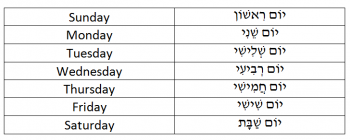How to Use the Hebrew Days of the Week in a Sentence Posted by Ayana on Jun 24, 2019 in Uncategorized
The days of the week in Hebrew don’t have special names, they simply follow a specific order: first day, second day, third day, and so on. The seventh day is the only exception that doesn’t bear numeral meaning in its name.
The Jewish week begins with Sunday:

יוֹם (yom) in Hebrew means day. For the Hebrew word today we add the prefix ה’ הַיְּדׅיעָה (hey hayedia) to the word יוֹם and receive – הַיּוֹם (a-yom). For example:
- הַיּוֹם יוֹם רְבִיעִי (today is Wednesday)
- הַיּוֹם אֲנׅי נׅשְׁאַר בַּבַּיׅת (I’m staying home today)
When you’ve lost track of the week and want to know what day it is, you should use the word אֵיזֶה (means which, what) and ask:
אֵיזֶה יוֹם הַיּוֹם? (ei-ze yom a-yom?)
- The long answer will be: הַיּוֹם יוֹם שְׁלִישִׁי (today is Tuesday)
- The short answer will be: יוֹם שְׁלִישִׁי (Tuesday)
- The shorter answer will be just: שְׁלִישִׁי (literally means third, but in spoken language also means Tuesday)
To describe something that happened on a particular day, or to set a plan for a specific day, we add the preposition בְּ (be, means on, in, by) before the day we refer to. For example:
- הָלַכְתּׅי לְשָׁם בְּיוֹם שֵׁנִי (I went there on Monday)
- אֲנׅי אֶקְנֶה לֶחֶם בְּיוֹם שִׁישִׁי (I will buy bread on Friday)
To describe a consistent action that takes place every specific day we add the preposition בְּ to the plural form of that day. The plural form of יוֹם (yom, day) is יָמׅים (ya-mim, days). The plural form of a specific weekday in Hebrew changes only the first word. The singular form of יוֹם רִאשׁוֹן, for example, becomes יְמֵי רִאשׁוֹן; the singular form of יוֹם שֵׁנִי becomes יְמֵי שֵׁנִי, and so on. Therefore, to describe consistent action that takes place every Tuesday we’ll say:
- בּׅימֵי שְׁלִישִׁי הוּא מְבַלֶּה עׅם אַבָּא שֶׁלוֺ (He spends time with his father on Tuesdays)
Or for another example:
- בּׅימֵי רְבִיעִי הוּא הוֺלֵךְ לַבְּרֵכָה (He goes to the swimming pool on Wednesdays)
When using the determiner every (כֹּל kol) before the day, there is no need to add the preposition בְּ, or to use the plural form of that day. For example:
- אֲנׅי מְבַקֶּרֶת אוֺתָהּ כֹּל יוֹם רְבִיעִי (I go visit her every Wednesday)
In spoken language you can even omit the word day when using the determiner every:
- אֲנׅי שָׁם כֹּל חֲמִישִׁי (I’m there every Thursday)
To define a time frame we use the prepositions מִ (mi, means from) and עַד (ad, means until). These prepositions can precede any time word, including days. For example:
- מׅיוֹם רִאשׁוֹן עַד יוֹם שְׁלִישִׁי אֲנׅי לֺא אֵהֲיֶה בַּמׅשְׂרָד (I won’t be at the office from Sunday to Tuesday)
- אַל תּׅדְאַג – אֲנׅי אַסְפּׅיק לׅקְנוֺת אֶת זֶה עַד יוֹם שַׁבָּת (Don’t worry – I’ll buy it before Saturday)
- הֵחֵל מׅיוֹם שֵׁנִי שְׁבִיתָה כְּלָלׅית בְּדוֺאַר יִשְׂרָאֵל (A general strike in the Israel Post Service will start on Monday)
A good way to practice the Hebrew days of the week and this post’s grammar is by the Hebrew nursery rhyme גַּרְגְּרׅים וְזֵרְעוֺנׅים (Grains and Seeds). The rhyme is taken from a children’s book by the same name, about a small chick with good appetite, that happily sings about his regular meal:
גַּרְגְּרׅים וְזֵרְעוֺנׅים זֶה הָאֹוכֶל הֲכׅי טָעׅים בִּשְׁבִילׅי,
מֵהַיּוֺם אֲנׅי אוֺכַל כֹּל יוֹם אוֹתוֹ דָּבָר:
בְּיוֹם רִאשׁוֹן – גַּרְגְּרׅים וְזֵרְעוֺנׅים,
בְּיוֹם שֵׁנִי – גַּרְגְּרׅים וְזֵרְעוֺנׅים,
בְּיוֹם שְׁלִישִׁי, רְבִיעִי וַחֲמִישִׁי,
וְגַם בְּיוֹם שִׁישִׁי – גַּרְגְּרׅים וְזֵרְעוֺנׅים.
אֲבָל בְּיוֹם שַׁבָּת יֵשׁ לׅי אֹוכֶל מְיוּחָד,
בּוֺאוּ וְתׅרְאוּ אׅם אֵינְכֶם מַאֲמׅינׅים,
כֵּן בְּיוֹם שַׁבָּת יֵשׁ לׅי אֹוכֶל מְיוּחָד –
הָמוֹן הָמוֹן הָמוֹן…
גַּרְגְּרׅים וְזֵרְעוֺנׅים,
גַּרְגְּרׅים וְזֵרְעוֺנׅים,
גַּרְגְּרׅים וְזֵרְעוֺנׅים.
Need a refresher on the days of this week? Read this related post:
The Days of the Week in Hebrew
שֶׂיּׅהֲיֶה יוֺם טוֺב! (Have a good day!)
Keep Calm and Learn Hebrew!

Build vocabulary, practice pronunciation, and more with Transparent Language Online. Available anytime, anywhere, on any device.




